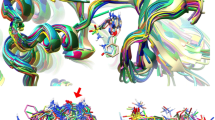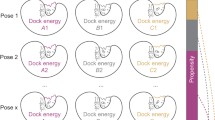Abstract
A possible way of tackling the molecular docking problem arising in computer- aided drug design is the use of the incremental construction method. This method consists of three steps: the selection of a part of a molecule, a so- called base fragment, the placement of the base fragment into the active site of a protein, and the subsequent reconstruction of the complete drug molecule. Assuming that a part of a drug molecule is known, which is specific enough to be a good base fragment, the method is proven to be successful for a large set of docking examples. In addition, it leads to the fastest algorithms for flexible docking published so far. In most real-world applications of docking, large sets of ligands have to be tested for affinity to a given protein. Thus, manual selection of a base fragment is not practical. On the other hand, the selection of a base fragment is critical in that only few selections lead to a low-energy structure. We overcome this limitation by selecting a representative set of base fragments instead of a single one. In this paper, we present a set of rules and algorithms to automate this selection. In addition, we extend the incremental construction method to deal with multiple fragmentations of the drug molecule. Our results show that with multiple automated base selection, the quality of the docking predictions is almost as good as with one manually preselected base fragment. In addition, the set of solutions is more diverse and alternative binding modes with low scores are found. Although the run time of the overall algorithm increases, the method remains fast enough to search through large ligand data sets.
Similar content being viewed by others
References
Kuntz, I.D., Blaney, J.M., Oatley, S.J., Langridge, R.L. and Ferrin, T.E., J. Mol. Biol., 161 (1982) 269.
Blaney, J.M. and Dixon, J.S., Perspect. Drug Discov. Design, 1 (1993) 301.
Colman, P.M., Curr. Opin. Struct. Biol., 4 (1994) 868.
Kuntz, I.D., Science, 257 (1992) 1078.
Lengauer, T. and Rarey, M., Curr. Opin. Struct. Biol., 6 (1996) 402.
Lybrand, T.P., Curr. Opin. Struct. Biol., 5 (1995) 224.
Jones, G., Willet, P. and Glen, R.C., J. Mol. Biol., 245 (1995) 43.
Oshiro, C.M., Kuntz, I.D. and Dixon, J.S., J. Comput.-Aided Mol. Design, 9 (1995) 113.
Clark, K.P. and Ajay, J. Comput. Chem., 16 (1995) 1210.
Gehlhaar, D.K., Verkhivker, G.M., Rejto, P.A., Sherman, C.J., Fogel, D.B., Fogel, L.J. and Freer, S.T., Chem. Biol., 2 (1995) 317.
Leach, A.R. and Kuntz, I.D., J. Comput. Chem., 13 (1992) 730.
Rarey, M., Kramer, B. and Lengauer, T., In Rawlings, C. et al. (Eds.) Proceedings of the ThirdInternational Conference on Intelligent Systems in Molecular Biology, AAAI Press, Menlo Park, CA, U.S.A., 1995, pp. 300–308.
Rarey, M., Kramer, B., Lengauer, T. and Klebe, G., J. Mol. Biol., 261 (1996) 470.
Welch, W., Ruppert, J. and Jain, A.N., Chem. Biol., 3 (1996) 449.
Rarey, M., Wefing, S. and Lengauer, T., J. Comput.-Aided Mol. Design, 10 (1996) 41.
De Clercq, P.J., Tetrahedron, 40 (1984) 3717.
Klebe, G. and Mietzner, T., J. Comput.-Aided Mol. Design, 8 (1994) 583.
Böhm, H.-J., J. Comput.-Aided Mol. Design, 6 (1992) 593.
Böhm, H.-J., J. Comput.-Aided Mol. Design, 8 (1994) 243.
Linnainmaa, S., Harwood, D. and Davis, L.S., IEEE Trans. Pattern Anal. Machine Intell., 10 (1988) 634.
SYBYL, Tripos Associates Inc., St. Louis, MO, U.S.A., 1994.
Morris, G.M., Goodsell, D.S., Huey, R. and Olson, A.J., J. Comput.-Aided Mol. Design, 10 (1996) 293.
Author information
Authors and Affiliations
Rights and permissions
About this article
Cite this article
Rarey, M., Kramer, B. & Lengauer, T. Multiple automatic base selection: Protein–ligand docking based on incremental construction without manual intervention. J Comput Aided Mol Des 11, 369–384 (1997). https://doi.org/10.1023/A:1007913026166
Issue Date:
DOI: https://doi.org/10.1023/A:1007913026166




